My visual world is born in everyday life, in the very closest. In this intimate sphere – the everyday, almost inconspicuous – I want to see and highlight the magnificent.
I am a mother of three who lives in a residential suburb of the capital. My life is neither exotic nor extreme, nor marginalized nor glamorous. I portray a reality I think most people recognize. In this ordinary everyday life, I look for the big, universal human questions – those that deal with the goal and meaning of life, about the longing for belonging and community.
When I was nine years old, I bought my first camera with saved money. A cheap pocket camera with three associated flash cubes. I photographed everything in my surroundings, the pictures depicted things like Christmas Eve, outings and birthdays, friends, cousins and various pets. The pictures were put together in albums that I flipped through, over and over. The photo albums were filled with events and situations that I wanted to remember and preserve. In this way, the photographs also became, to some extent, testimony that I was part of a context larger than myself. I still save my photos in albums, they are getting more and more and now fill several meters of shelf space in my home. For me, photography has become a way to take in my surroundings and try to interpret the flow that is life.
Photographs are a narrow slice of time. They are an attempt to preserve the moment, preserve the context. Maybe our pictures are nothing more than testimonies, memory pictures of contexts that we can bring up in moments of longing? The need to feel significant, involved and needed in a context outside of ourselves is one of our most basic. We want to feel that we have an important role to play, be it in an organization, in a family or in someone else’s life. This need to be needed is rooted in a longing to contribute to something greater, beyond ourselves. When the sense of contribution or involvement disappears, we lose purpose and direction in life.
My childhood photographs have faded over time in their albums. The poor technical quality of color film from the 70s has caused the images to slowly fade away. Holidays, birthdays and outings are marked today with distorted colors and clear, transparent motifs. Ironically, the images have been consumed by the volatility I wanted to combat when I took them. Impermanence cannot be escaped, but the only thing I can do is continue to photograph.
Anna Clarén made her debut in 2006 with the book and exhibition Holding, which in the same year won the prize for best photo book in Sweden. After that, she made several larger photographic series which became books and exhibitions. Holding (Journal 2006), Puppy Love (Journal, 2009), Close to home (Max Ström, 2013), When everything changed (Max Ström 2018) and Need to be needed (Max Ström 2023). Anna Clarén is considered one of the most influential contemporary photographers in Sweden, she has had solo exhibitions at, among others, Dunkers in Helsingborg, Malmö Museums and at Fotografiska in Stockholm. Clarén’s pictures are represented at several government bodies, including the Statens Konstråd and Moderna Muséet in Stockholm. Anna Clarén is one of the main teachers at Norden’s photo school, Biskops Arnö, where she has been involved in training a new generation of photographers and photojournalists in Sweden.





